Animals of the Amazon Rainforest
The Amazon rainforest is the largest and most important rainforest in the world. The tropical rainforest surrounds the Amazon basin and covers nearly half of all of South America. Due to its location and the tropical climate, there is no other place on earth where so many different organisms live as in the Amazon region.
Animals of the Amazon Rainforest
Top 40 Animals you are likely to encounter in the Amazon Rainforest
The Amazon Rainforest has one of the most diverse types of animal species and plants that can only be seen in the Amazonas region.
Unfortunately, some of these animals may no longer roam the earth in decades. Below we list a selection of the animals that you may encounter during the Amazon tours in Brazil.
We have divided them into the following categories:
OFF ROADS TRAVEL
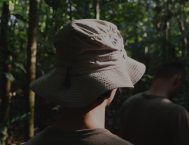
If you dream to discover the beauty and mystery of the Amazon rainforest, an Amazon jungle tour with a native guide for whom the jungle has always been home, is the best choice for you. Due to our expertise we offer the most authentic Amazon Jungle Tours to get to know the Amazon area.

Mammals
1.Jaguar
The first animal on the list is the least likely to be seen in the wild of all the animals that live in the rainforest. The jaguar’s habitat in the Amazon Rainforest has declined over time due to deforestation. Additionally, the jaguar has fallen victim to hunting in the recent years. Of this animal there are still about 170,000 on earth, which makes the animal almost threatened. Around half of the population can be found in Brazil.
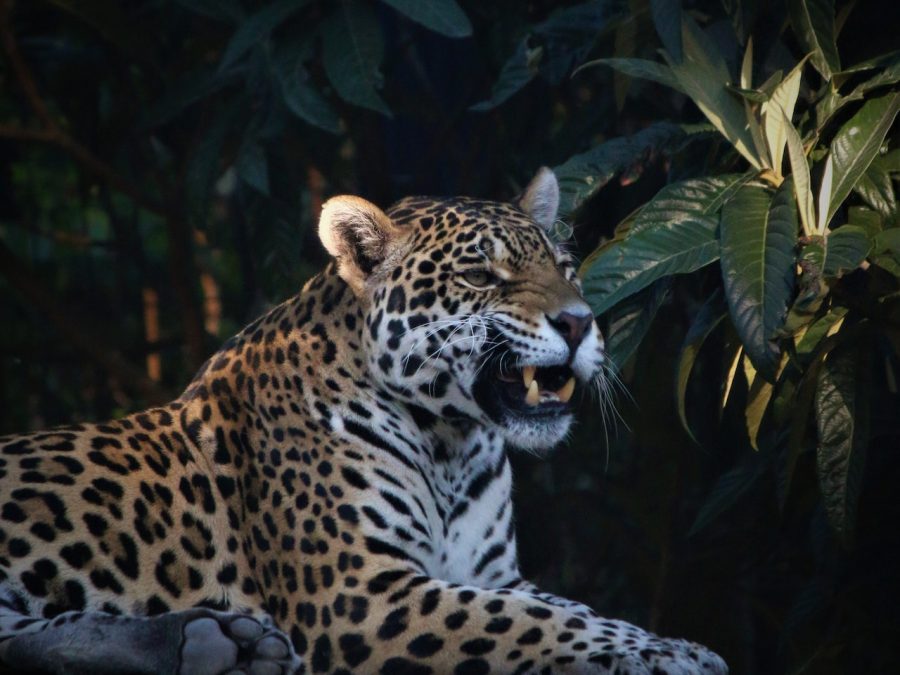
The jaguar is South America’s largest cat and the largest predator of all the animals of the Amazon Rainforest.
The jaguar is very similar to its closely related African cousin the leopard. However, he is somewhat heavier built and has a shorter tail. It lives mainly in the dense forests, but if there is also plenty of food to be found in open areas, you can find them there too. The jaguar hunts both on the ground and in trees, as it is also an excellent climber. He is also exceptionally good at swimming. The food of the jaguar consists of various mammals and birds. The jaguar also eats fish that it fishes out of the water with its strong claws. Jaguars have even been seen regularly catching a caiman from out the water.
The jaguar is truly the king of the jungle. Jaguars live solitary. This means that they do not live in groups but individually. The animals only come together to mate. Then the males and females separate again.
2.Pink River Dolphin
The Amazon pink river dolphin is the largest species of river dolphin. The river dolphin, like other dolphins, is very friendly to humans. They are often seen alone or in pairs. The Amazon river dolphins are extremely fast swimmers and fish eaters. The pink dolphin has a very diverse diet consisting of more than 53 fish species.

The Amazon river dolphin is completely adapted to life as jungle animals of the Amazon Rainforest. With their flexible necks they can effortlessly hunt for fish between the roots of the
trees in the river.
Pink river dolphins take 5 to 6 years to reach maturity. Immediately after birth, the calf is pushed to the surface to breathe. The indigenous tribes of the Amazon region have many legends about these animals. They also call the animal “Botos”
During Amazon tours in the Manaus region is possible to swim with these animals in their natural habitat.
3.Capuchin Monkey
The capuchin monkey is a very small monkey that roams the trees of the rainforest. This monkey species has a size of 25 to 35 cm when it grows. They tend to live together in groups, sometimes in groups of more than 500 members. They live in the wild for about 15 years.
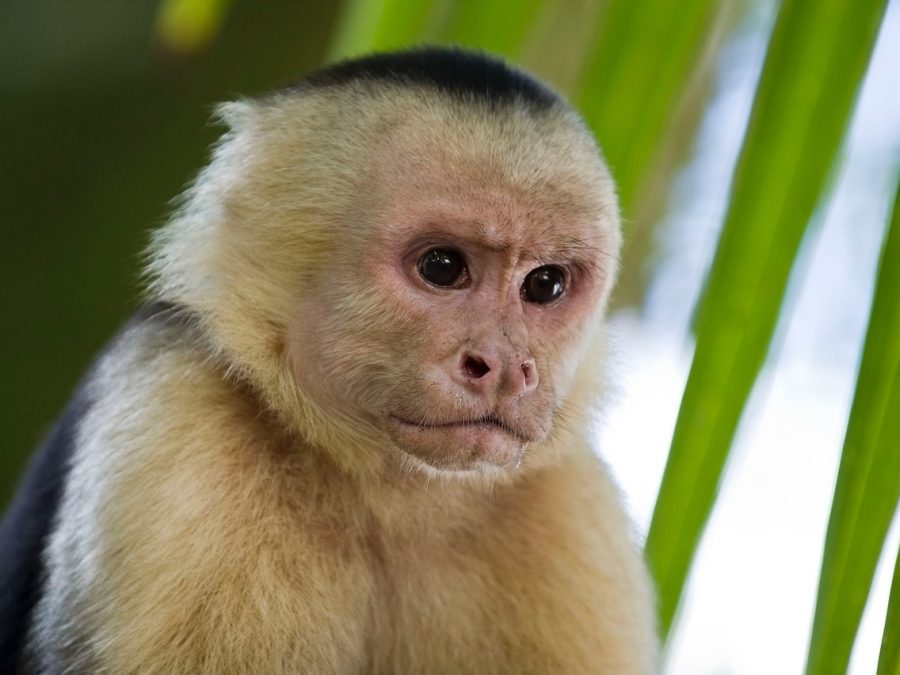
The capuchin monkey is considered to be one of the most intelligent animals of the Amazon Rainforest. They are especially noted for their tool usage. The capuchin will use stones, some of them weighting as much as the monkey, to crack open the fruits to get to the nuts inside. Because of their intelligence capuchin monkeys are the most common featured monkeys in movies, with examples including: Night at the Museum, Pirates of the Caribbean, The Hangover and Friends.
Almost 40% of the Amazon Rainforest can be found in Brazil.
4.Sloth
Sloths are perhaps the strangest animals of the Amazon Rainforest. These mammals have adapted themselves in a unique way to life in the trees. There are different types of sloths which are divided into the two toed and three toed sloth. All species are found in the rainforests of Central and South America. The two toed sloth are the most common in the Amazon jungle of Brazil and the three toed sloth lives especially in Central America.
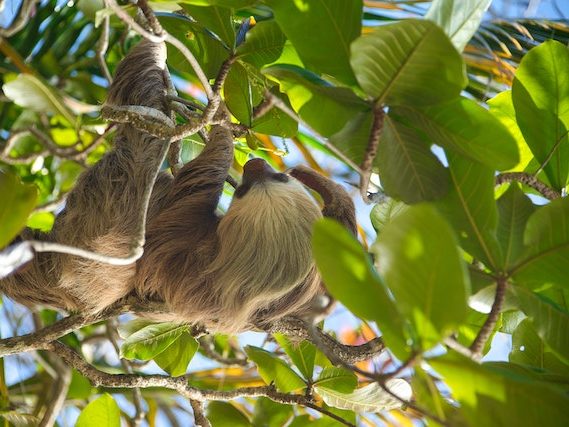
Sloths spend most of their lives hanging upside down, moving extremely slowly. They also eat, sleep, climb trees, mate and give birth while hanging upside down. Although the animals are very slow, they can defend themselves well by striking with their claws. They feed on buds, shoots, flowers, leaves and young twigs. If you’re lucky, you can encounter the sloth and see it in the wild in our authentic Amazon jungle lodges, deep in the Amazon Rainforest.
5.South-American Tapir
The Amazonian tapir is one of the oldest species of all animals of the Amazon Rainforest. He is considered a “living fossil,
a survivor of the geological period many thousands of years ago.
The tapir looks like a cross between a pig, a horse and an elephant. The tapir has a long moveable nose that it can retract, like an elephant’s trunk, except the tapir doesn’t use it to grab something, but to smell and feel. Tapirs prefer to live near running water and they can swim well.
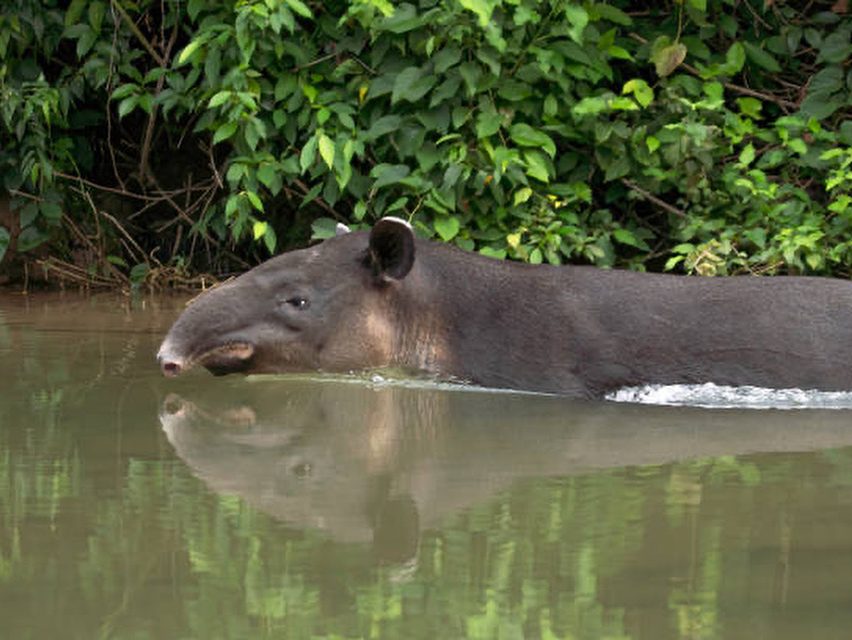
The food of the tapir mainly consists of leaves,
shoots, tender twigs, but also fruit, grass and water plants.
Tapirs live solitary and are not very friendly with each other, except during the mating season. The female gives birth to only one young at a time and at birth the young is covered with stripes and spots. When out and about, the tapir always takes the same road, creating clear paths and tunnels through the dense vegetation.
6.Black-capped squirrel monkey
The habitat of the black-capped squirrel monkey extends over part of Central America as far as South America. They mainly live in forests along large rivers and in the edges of extensive forests. These monkeys, who often roam in large groups, are very mobile. They are often in the treetops
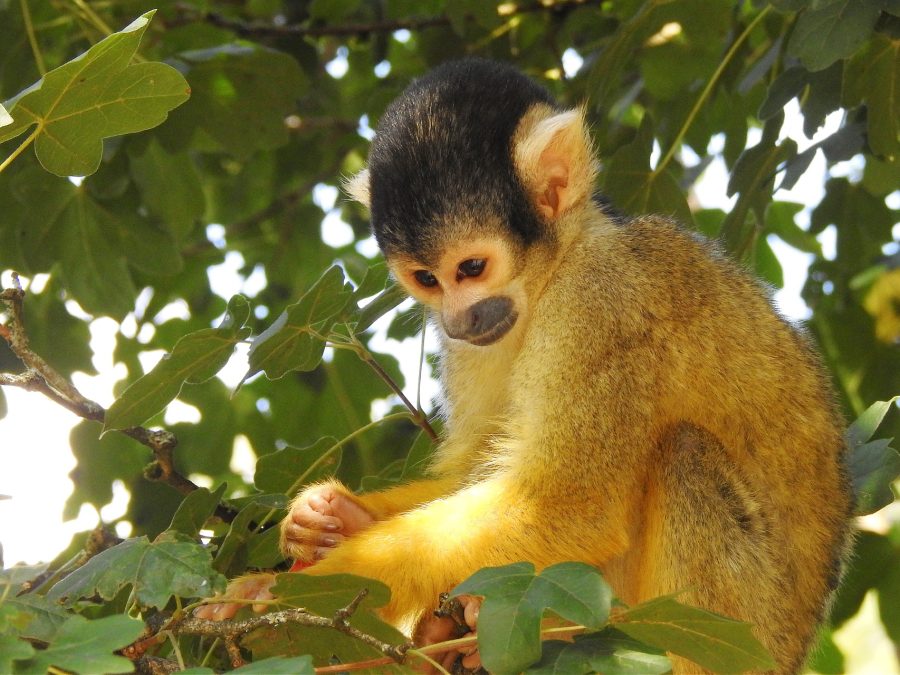
When resting in the trees, they let their long tail hang down for better balance. The tail of the squirrel monkey
has no grasping function.
Squirrel monkeys feed on berries and other fruits, but also on animal food such as snails, spiders, tree frogs and crabs.
This monkey species is very curious and there is a high chance of encountering these animals during a trip through the Amazon jungle.
7.Margay
The margay is the most common cat in Central and South America. Only because of its length and camouflage it is difficult to see. He has a very nice spotted coat and big eyes that allow him to see well in the dark. The margay is an excellent climber that lives mainly in the trees.
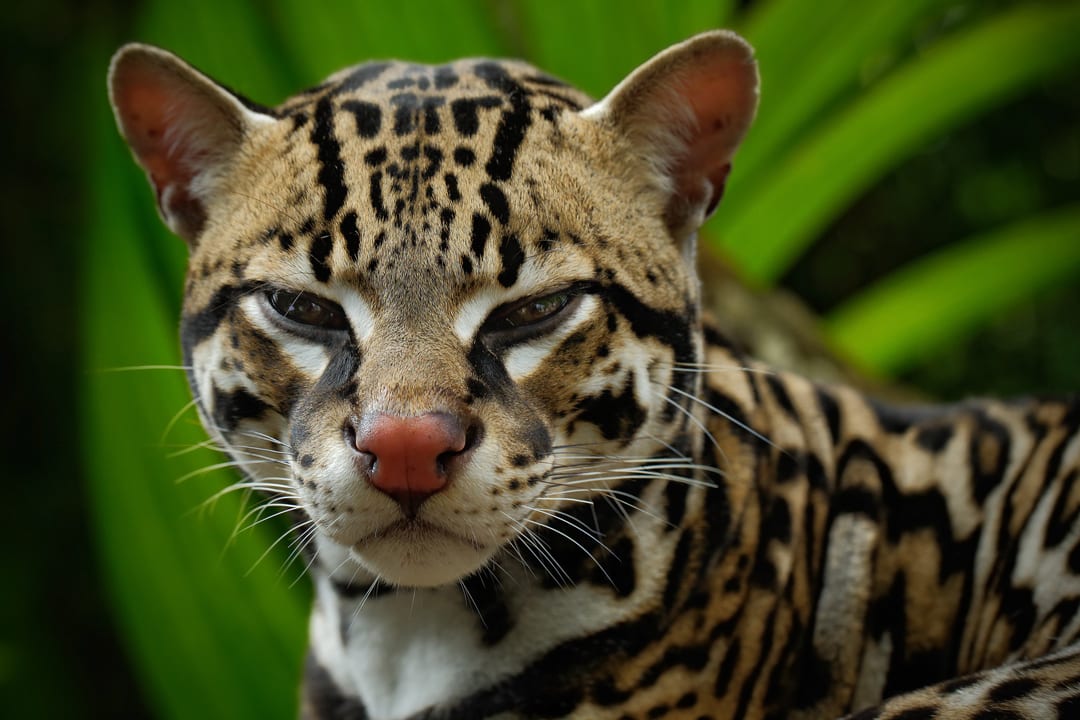
It eats monkeys, opossums and birds. After three months’ gestation, the female gives birth to 1 or 2 cubs. If human destroys his natural environment, he cannot adapt to another environment. In addition, it does not reproduce in captivity. Therefore, the margay is an endangered species.
The Amazon Rainforest contains one in 10 known species on Earth.
8.Giant Anteater
The giant anteater is one of the strangest animals of the Amazon Rainforest, like the sloth, belongs to the toothless animals. Like a giant vacuum cleaner, it sucks up ants and termites. First he destroys the anthills and termite mounds with his strong claws, and then he sticks his 40 centimeters long, sticky tongue in them.
The giant anteater can eat up to 30,000 ants a day. The most special thing about this animal is its long, funnel-shaped head with a very small mouth at the end from which its long tongue comes out. The anteater is obstinate, but when attacked, it defends itself fiercely with its claws. After a gestation of six months, the female gives birth to 1 young, which stays with her for two years. In those two years she often carries it on her back. When the young is big enough, it lives on alone.
9.Capibara
Capybaras are the world’s largest rodents. They live both in the water and on land. Capybaras can stay underwater for up to 10 minutes and can dive for considerable distances .Their habitat mainly consists of the tropical areas of the Amazon rainforest to the wet grasslands of the Pantanal. Capybaras are on the menu of, among others, jaguars.
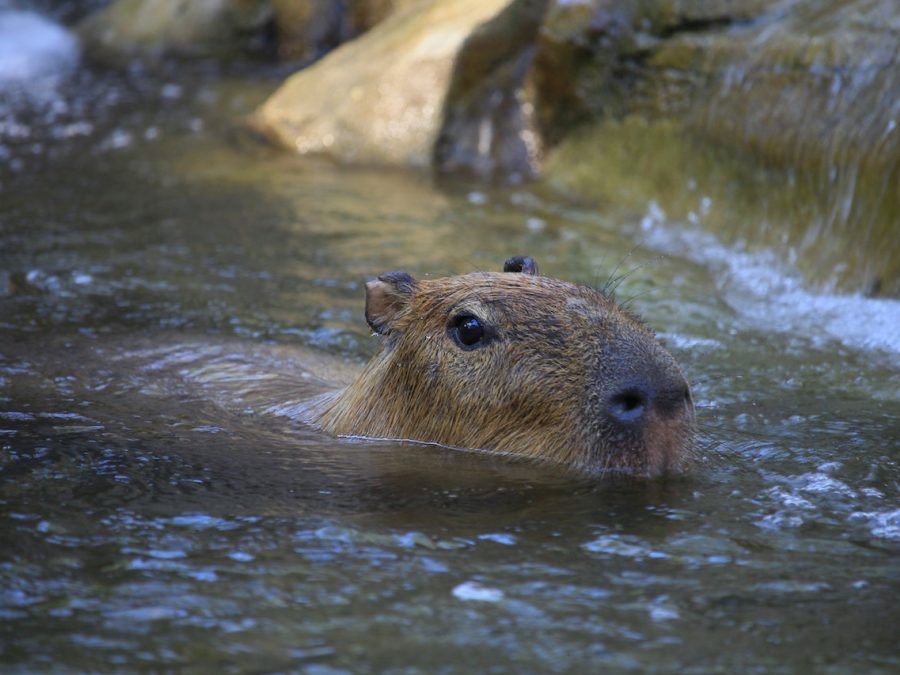
But people also hunt for these animals, which yield a lot of meat and whose skin is also used to make leather. In areas where people intensively hunt capybaras, they are less visible during the day and only move at night.In the afternoon heat they prefer to stay in the water. In this way
the animal always adapts to the environment.
The population of the capybaras is huge and they reproduce quite quickly. Fortunately, capybaras are therefore not in danger of extinction.
10.Giant River Otter
The giant otter is the world’s largest otter species in the and is found in the humid lowlands of the Pantanal and Amazon basin. They can grow longer than 2 meters and weigh up to 40 kg. Together with the jaguars, the anacondas, the harpies and caimans, they are among the major predators of South America. The giant river otter feeds on everything it finds in the waters where it lives, but especially on fish. The giant otter is a lively, curious, little timid animal that can swim very well.
They have membranes between the fingers and toes, which makes it easy for them to swim. To accelerate,
they use their tails.
The giant river otter lives mainly in groups that can consist of up to 20 members. Because they eat a lot of fish and therefore sometimes bother the local fishermen and also for their skin, these animals were hunted a lot. Therefore, the giant otter is classified as “endangered”.
The population of the capybaras is huge and they reproduce quite quickly. Fortunately, capybaras are therefore not in danger of extinction.
11.Puma
The Puma is a feline that is more like the domestic cats than like the lion or tiger. You could say that they are the largest of the small felines. Of all the other big cats they are the 5th largest. Of all the felines, the lion, tiger, leopard and jaguar are larger. Male pumas are about 62 kilograms and 2.5 metres long.
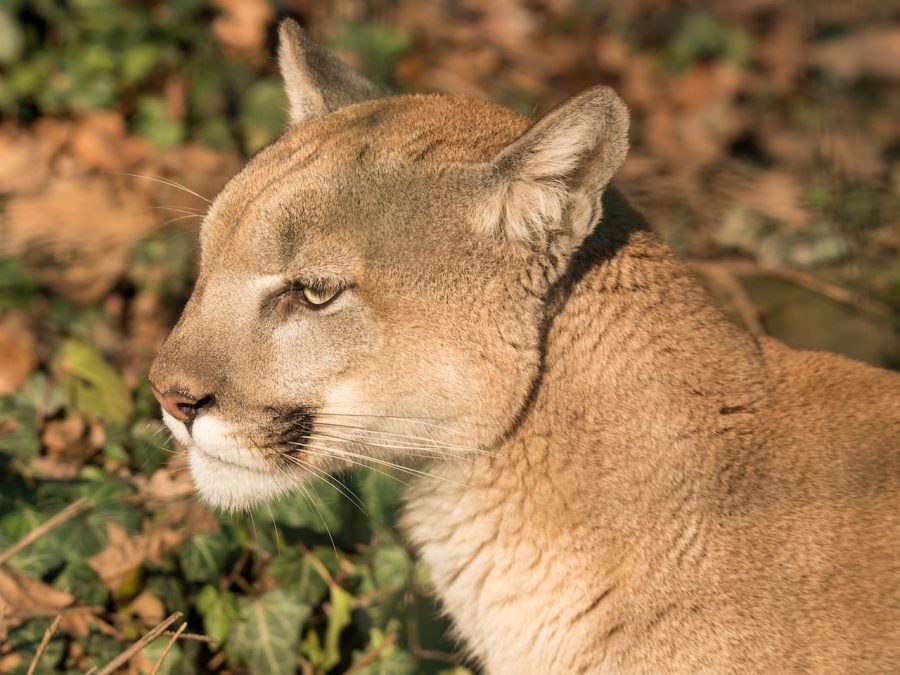
The puma communicates through growls, chirps and whistle sounds. This magnificent animal has several names including mountain lion, panther and cougar. The reason why this cat has so many names is due to its wide distribution. The puma occurs from the southernmost part of the Andes to Canada. This gives the animal the largest range of all large living land mammals in the Western Hemisphere.
The puma is a carnivore and hunts by ambush. The animal stalks its prey between rock ledges, trees or bushes to eventually jump on the back of the victim, to deliver the fatal neck bite. It hunts a broad spectrum of animals. The main diet consists mainly of deer, horses and sometimes moose. The cougar supplements its diet by hunting small rodents and large insects.
12.Collared Anteater
The Collared Anteater is smaller than its relative the giant anteater. It has a body of around 60cm and a tail of around 35cm. The collared anteater is found in central and South America. The collared anteater has a distinct advantage over its relative the giant anteater and that is that it does not have to live on the ground alone.
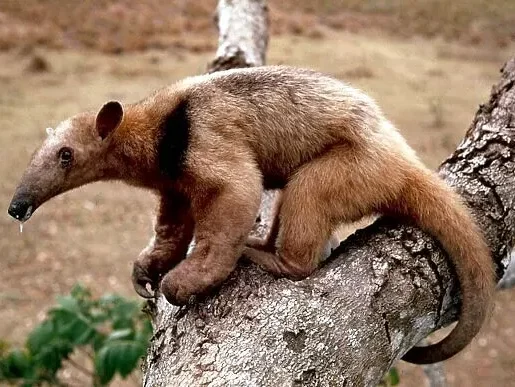
Thanks to their prehensile tails they can climb trees and look for food there. With their 40 cm long tongue which is covered in sticky saliva, they can slurp all kinds of insects from the trees.
The collared anteater has poor vision but they compensate for that with their excellent sense of smell. Like the giant anteater and the armadillo, they have long talons with which they can easily break through termite holes.
Since 1999 researchers found over 2000 new species of plants and animals in the Amazon Rainforest.
13.Howler Monkey
The Howler monkey is considered one of the loudest animals on earth. The reason why this primate species can make so much sound is because of a so-called “hyoid bone,” which in humans is like a horseshoe but is larger and more bowl-shaped in these monkeys. This makes this monkey sound extra amplified and his sound echoes throughout the jungle.
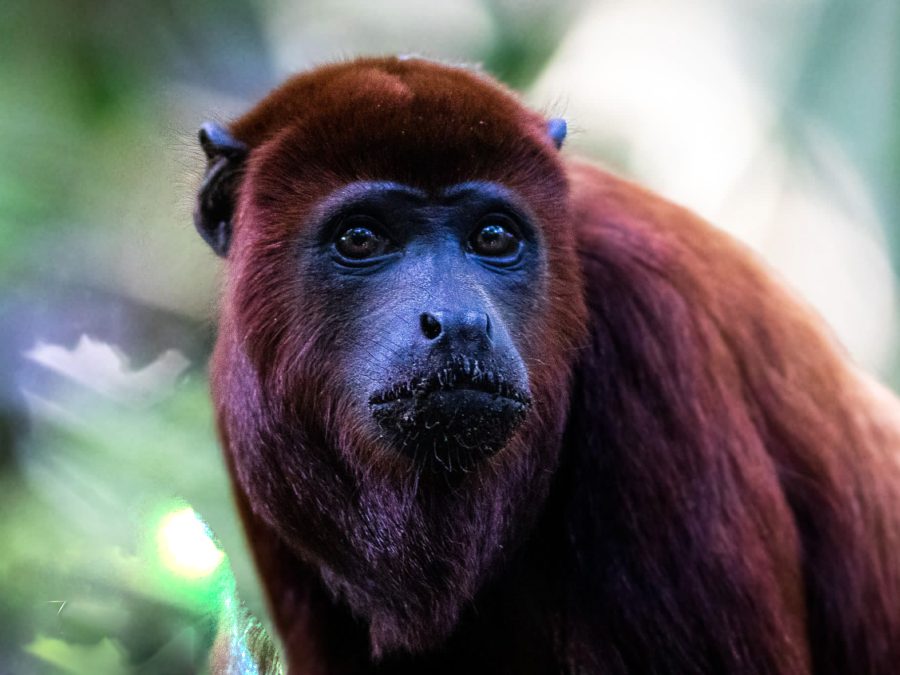
Only the male howler monkeys roar. They are very territorial and probably do this to show other males their dominance. Fortunately for the other jungle animals, they also sleep 15 hours a day, as they make quite a sound when awake.
The howler monkey lives high in the trees and their diet consists mainly of leaves, insects, fruits and flowers. They have long tails that are actually used as a fifth hand so they can better identify things in their habitat.
14.Giant Armadillo
The giant armadillo is the largest armadillo species and can grow up to 1.5 metres long. The giant armadillo is on the IUCN list.
This means that the animal is threatened with extinction.
This Amazonian animal lives mostly alone and sniffs around the Amazon region especially at night. The giant armadillo makes large burrows in which they shelter during the day.
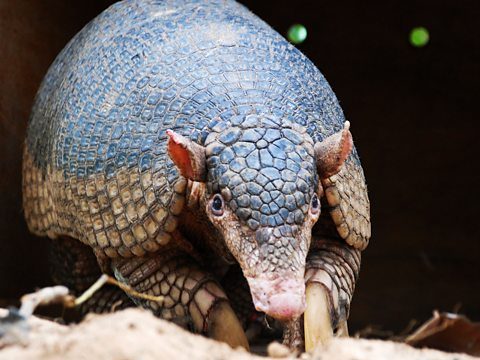
At night, the giant armadillo goes in search of food. They eat mostly termites and ants. They use their large claws to break open termite mounds. Furthermore the giant armadillo also eats animals like spiders and worms.
When they feel threatened they can quickly backtrack to the nearest opening of their burrow. The giant armadillo weighs about 30kg (66lbs) and can run almost 50km (30mph) per hour. The animal lives to be about 12 to 15 years old.
15.Pygmy Marmoset
The Pygmy Marmoset is a very small mini monkey, living high in the canopy of the jungles of South America. The pygmy marmoset has brown fur and a long tail and is the smallest monkey in the world. An adult Marmoset fits in the hand of a human and weighs about the same as a lump of butter.
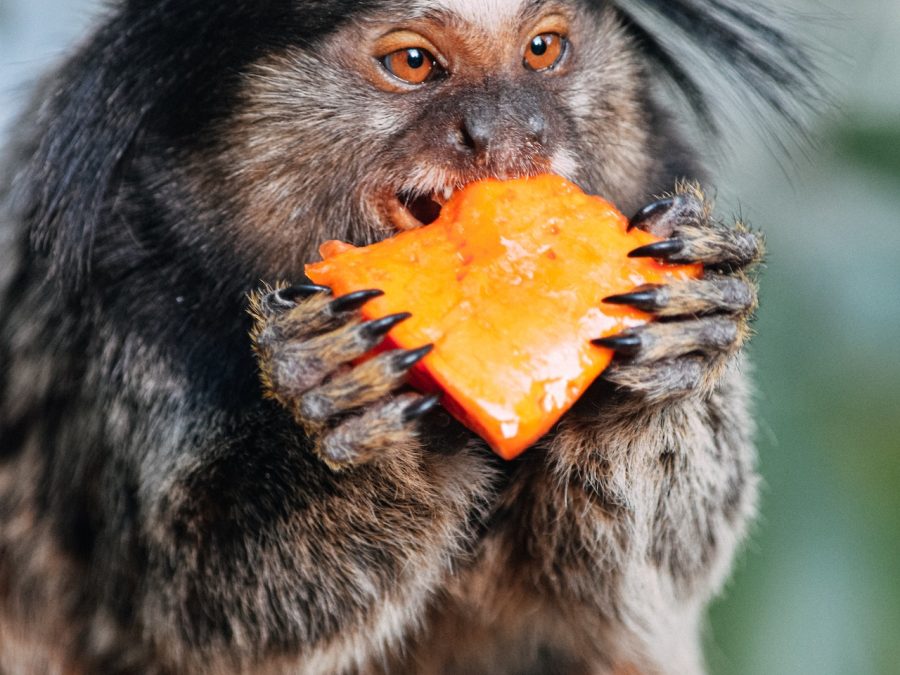
Because this animal is so small there are many predators that hunt them. The major enemies of the animal are snakes, raptors and small felines. In some cases, the monkeys exhibit mobbing behaviour in which the entire group moves toward an intruder and attacks while singing loudly until the attacker retreats. Other times they remain rigidly seated until the attack is over.
16.Bearded Emperor Tamarin
The bearded emperor tamarin is a grey and silvery brown monkey with a reddish tail. A striking feature of the monkey is its curled moustache. The small monkey is usually awake during the day and lives high in the trees with groups of 2 to 15 members.
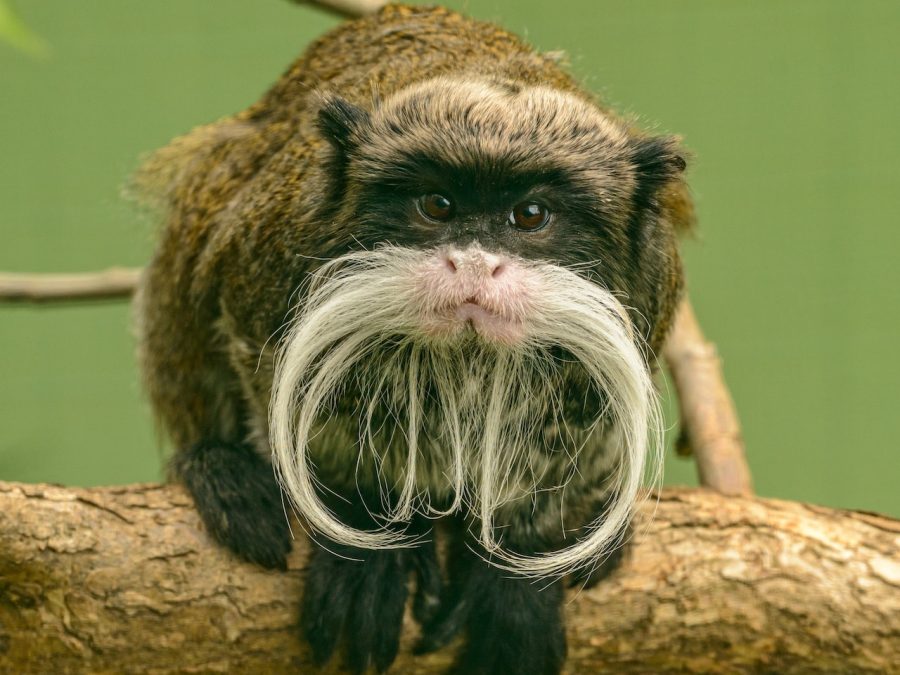
The bearded emperor monkey is very territorial. They protect their territory very well and react very violently if intruders enter their territory. They use shrill high-pitched tones to warn the intruders. These primates also communicate a lot through smells. They mark their territory by leaving scents on branches and leaves. A funny fact about these monkeys is that when they go to sleep, the whole family crawls together in the hollow of a tree.
17.Brown Woolly Monkey
As the name suggests, this brown woolly monkey has a short thick coat that covers their entire body. This monkey can be found in different parts of South America and in different areas they often have a slightly different colour of coat as well. For example, the black and grey monkeys are more common at the foot of the Andes in Colombia and the animals in Brazil are more likely to have an olive-like colour.
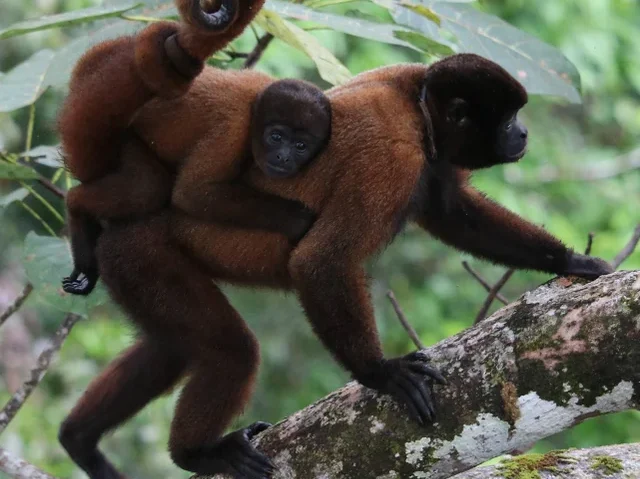
These monkeys live in the tops of trees and are active during the day. They spend a lot of time looking for food and cover about 2 kilometres daily. When eating, these monkeys often use their tails to hold on too they also play with it and can even pick up objects with it. Woolly monkeys live in groups of 2 to 70 members, which are often divided into smaller subgroups when they are active. The monkeys communicate through sounds or facial expressions. The sound this monkey makes is often used as a danger signal and sounds like a scream or a bark.
18.Peccary
Also called javelin or javelina, the peccary is one of three species of pig-like mammals. On first glance the peccary is very similar to a small version of the wild boar as it has dark coarse hair and a large head with a rounded snout.
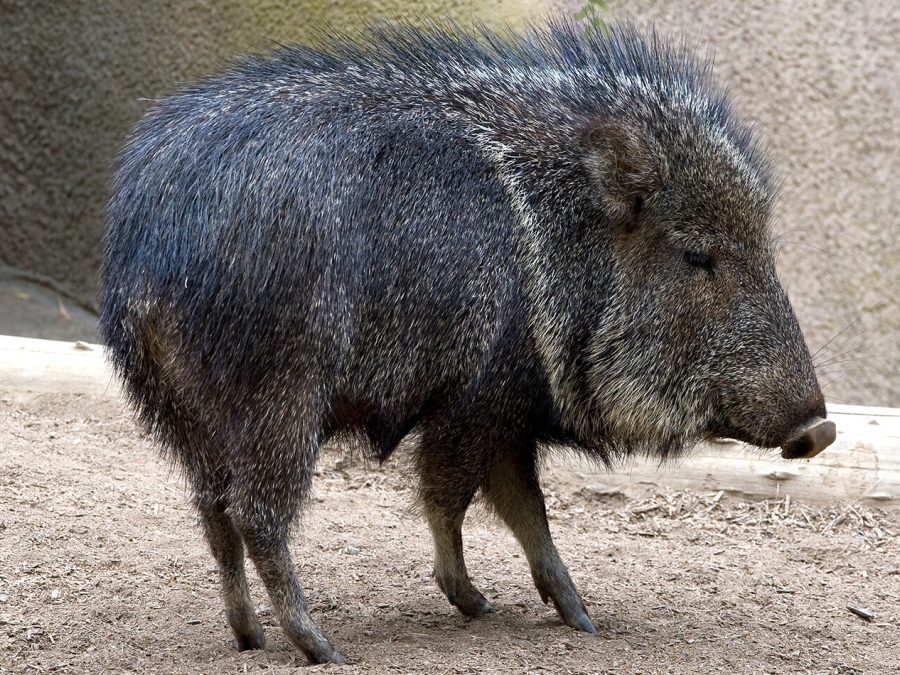
The peccaries are also excellent gardeners as they replant their food sources. They destroy some seeds as they eat, but they also spit the larger seeds back near the parent plant. Smaller seeds pass through their digestive tract and then germinate in other areas far from the mother plant. They also take prickly or sticky seeds with them on their fur which then germinate in another area of the jungle.
Birds
19.Macaw
The Macaws or Aras are colorful birds that live in the South American rainforests. They mainly eat nuts that they break open with their strong beaks.

Macaws are very intelligent and social birds. They often live in groups of up to 20 birds. In the Amazon rainforest you have a good chance of hearing these birds before you see them. They scream very loudly to communicate with each other. They are even capable of imitating human language.
20.Harpy Eagle
As with most eagles, the female harpy eagles are twice the size of the male eagles. These eagles are very good at conserving precious energy. You will never see a harpy eagle flying over the top of the rainforest. Instead, the harpy eagle flies under the canopy of the jungle in search of prey. At 13 inches larger than a grizzly bear, this predator’s claws are perfect for grabbing prey such as monkeys and sloths from the tops of trees.
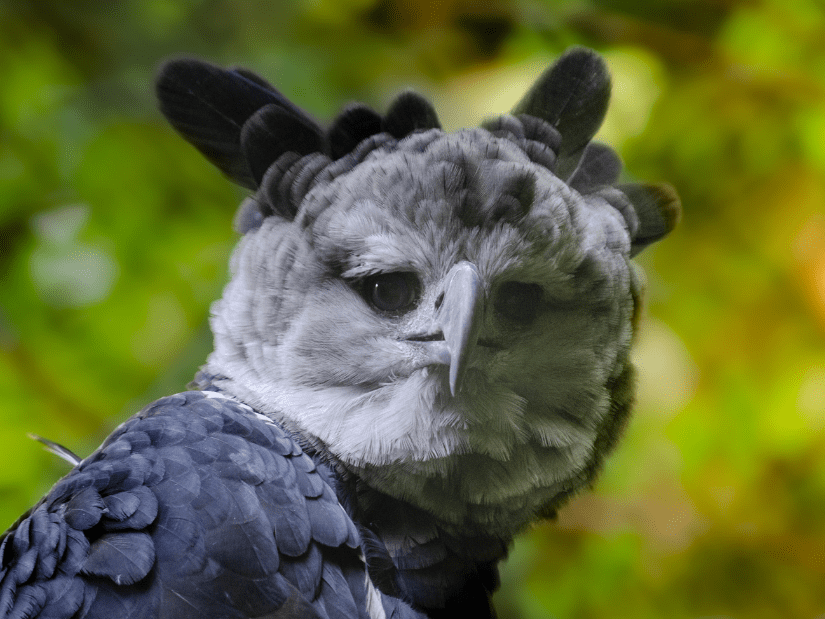
As parents, harpy eagles defend their eggs very fiercely. These raptors reproduce only once every 2 or 3 years and are monogamous animals. They can go with the same partner for the rest of their lives. Both parents incubate the eggs with the female taking most of the responsibility. Often the harpy eagle lays 2 eggs. The first egg gets all the attention in the raising process, while the second egg serves as a sort of “back up plan” for when the first egg doesn’t make it for some reason.
21.Toco Toucan
The Toco Toucan feels at home in the rainforest of South America and is the best known and largest toucan species. The Toco Toucan is a common toucan in this area and during jungle tours it is also one of the most commonly seen birds.
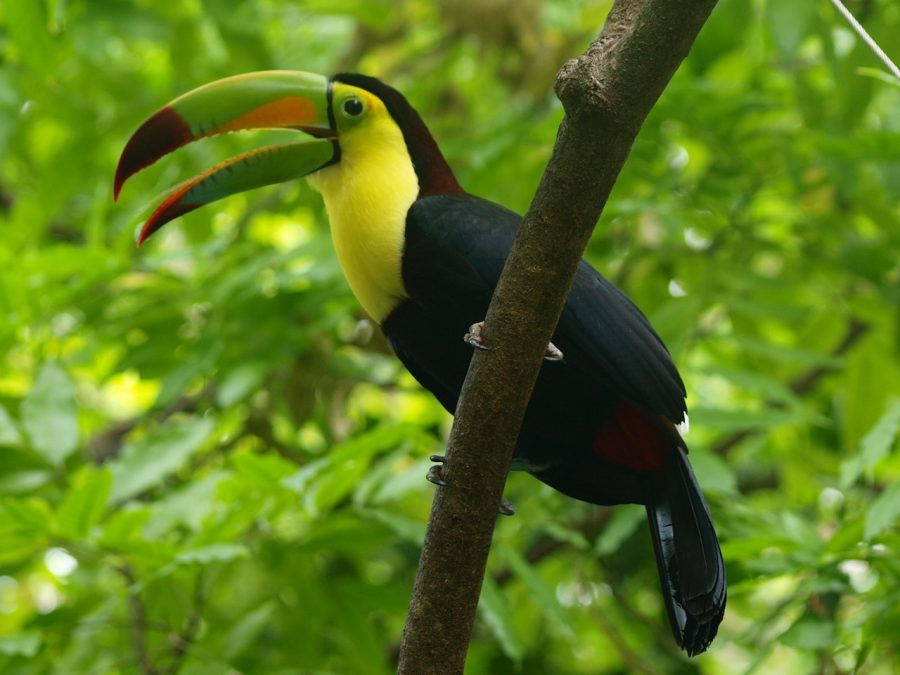
This toucan can be recognized by its large colourful beak, which makes up almost half of their length and has also made it one of the most famous birds on earth.
The exact reason why these birds have such a huge beak is not entirely clear
though it is believed that they help in the court making ritual or for self-defence.
This toucan tends to jump more than fly. They hop from branch to branch in the tops of trees in search of food. The toucan makes grunting and snoring sounds. These sounds are also often compared to the croaking of frogs.
22.Hyacinth Ara
The Hyacinth Macaw is known for its beautiful blue color and is the largest macaw species. These macaws lay 2 to 3 eggs per nest and are monogamous animals. Macaw pairs remain attached to each other for life. These Macaws travel primarily in small groups of about 1 to 8 birds and communicate with each other through sounds. Hyacinth Macaws can imitate human sounds and are cheerful and intelligent animals. These Macaws can fly fast and at their top speed fly as much as 56 km per hour.
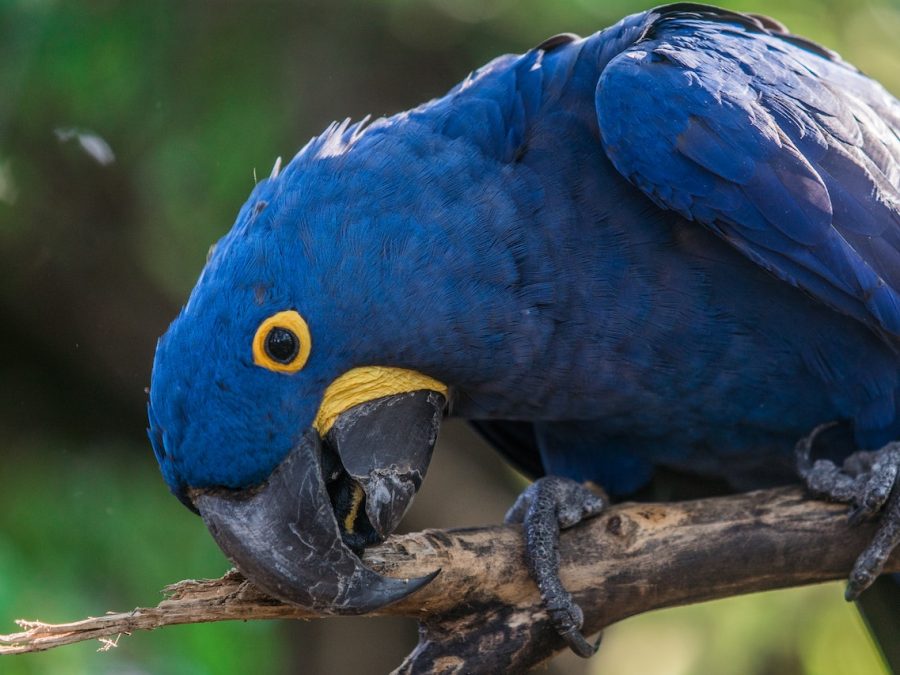
The Hyacinth Macaw is only found in southern Brazil and western Bolivia. In total, it is estimated that there are between 2,500 and 10,000 left of this beautiful bird. Hyacinth Macaws are also known to eat many seeds and nuts and defecate them on the forest floor. As a result, they promote vegetation in the area.
23.Caique
Caique Parrots are native to the Amazon of South America. These parrots prefer to live under the canopy and are very good climbers. They move by walking, flying and jumping through the tops of trees. The Caique is a medium-sized parrot and are very intelligent parrots.
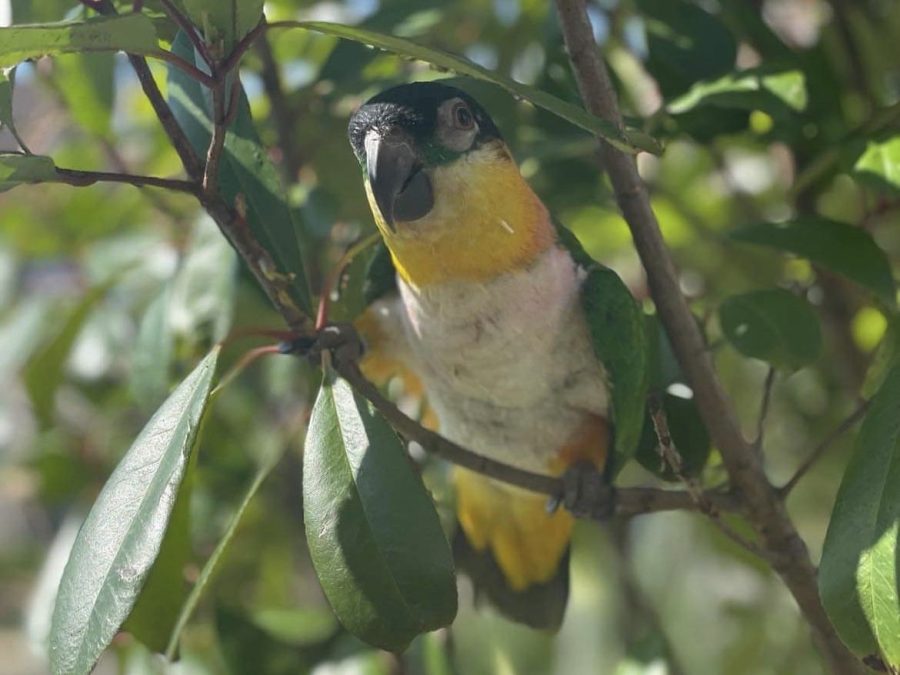
There are two types of Caique. The black headed caique and the white headed caique. The black headed caique is found in areas north of the Amazon River. The countries in which the black headed caique occurs are: Brazil, Colombia, French Guiana, Venezuela and Perú. The white-headed caique occurs south of the Amazon River in countries such as: Brazil, Bolivia and Perú
A fun fact about this parrot is that a person can determine what emotional state the bird is in by the smell of the bird. Happy Caiques have a sweet smell while sad caiques smell like cardboard.
Reptiles & Amphibians
24.Poison Dart Frog
The poison dart frogs wear the most brilliant colours on earth. They can be found from Costa Rica to Brazil and can be coloured gold, yellow, green, red, copper black and or blue. They have all these colours to warn potential predators.
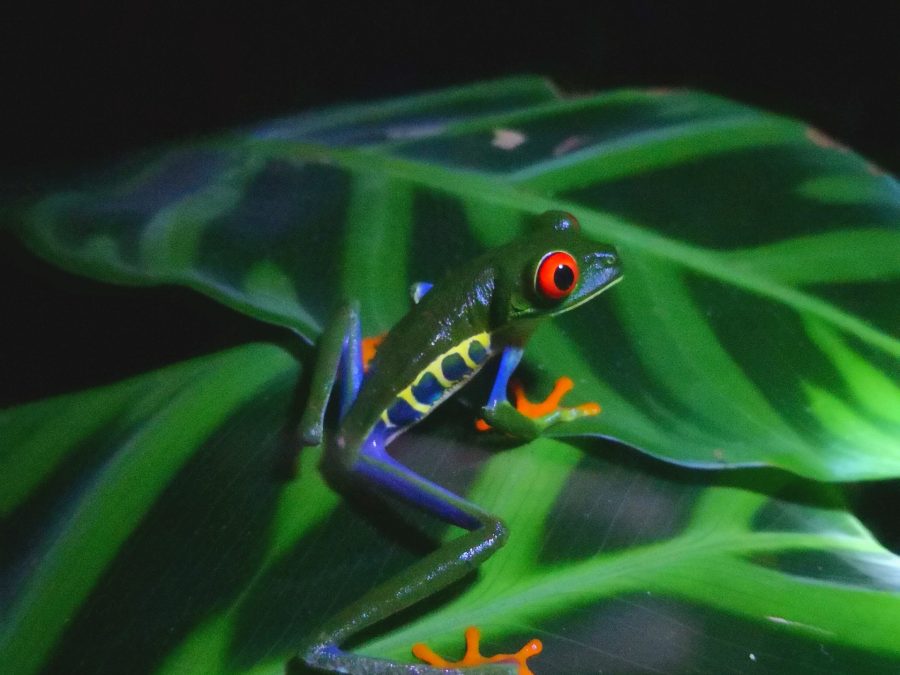
The Dendrobates frogs are one of the most poisonous animals on earth. The golden poison frogs are 2 inches long and have enough poison to kill 10 adult males. Various indigenous populations have used the poison as the tip of their bladed arrows while hunting for thousands of years. Scientists don’t know exactly why these frogs are so poisonous. They think it’s because they ingest plant toxins carried by their prey: such as beetles, ants and termites. In fact, poison dart frogs that grow up in captivity and are isolated from insects from their natural habitat never develop poison. The frog’s venom is also used in medicine.
25.Green Anaconda
The green anaconda, also known as the giant anaconda, is part of the boa family and is found only in South America. With an average length of 6 metres and a top length of 8.8 metres, the green anaconda is one of the largest snakes on earth. This snake is an excellent swimmer and can also be found in the Amazon River and surrounding swamps.
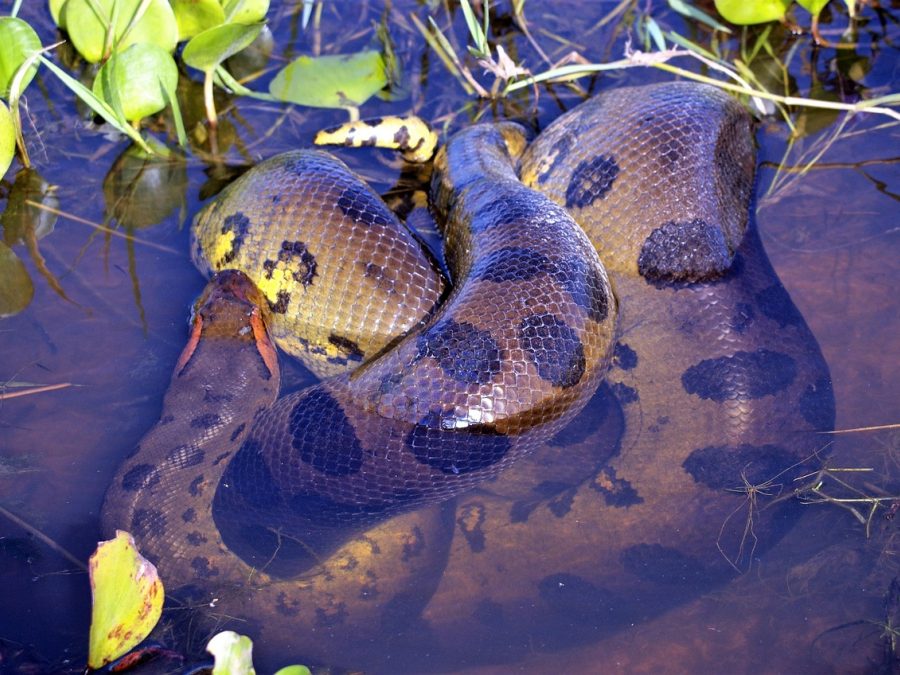
Unlike many other snakes in the jungles of South America, the green anaconda is not poisonous. When the green anaconda sees prey it grabs it with its jaws and strangles it until it is suffocated or crushed.
Then the green anaconda swallows the dead animal whole. After a large meal, this snake can go for weeks without eating before it has to start hunting again.
Green anacondas spend most of their lives alone. Only in April and May do the male anacondas search for females so they can mate. Often several males will go after the same female, creating “brood balls.” This means that there are sometimes up to 12 males creeping around the same female, all trying to mate.
26.Black Caiman
The black caiman is found in large parts of South America where it dwells in various freshwater habitats. The black caiman can reach a length of 6 metres, making it the largest of the caiman family and the largest predator in the Amazon.
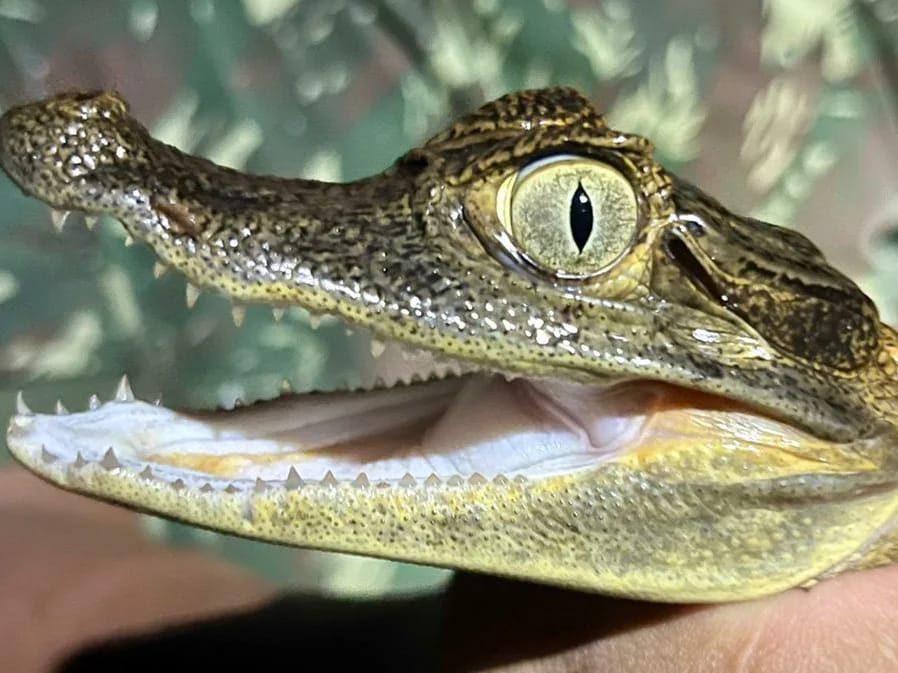
The diet of this caiman species consists of fish (including catfish and piranha) and other animals such as turtles, birds and other land animals, like deer and capybaras. When these animals come to drink at the water’s edge, the caiman strikes quickly to catch their prey. Larger black caimans may also devour prey such as anacondas and Tapirs. The healthy adult black caimans have no other predators hunting them except the jaguar and humans. The teeth of these caimans are designed so that they only grab their prey and do not tear it apart. They then push their prey underwater before drowning and eating them.
27.Green Leguana
The green iguana is a large lizard species that is also very popular to have as a pet nowadays. This species of iguana is mainly found in South America but can also be found in Central and North America.
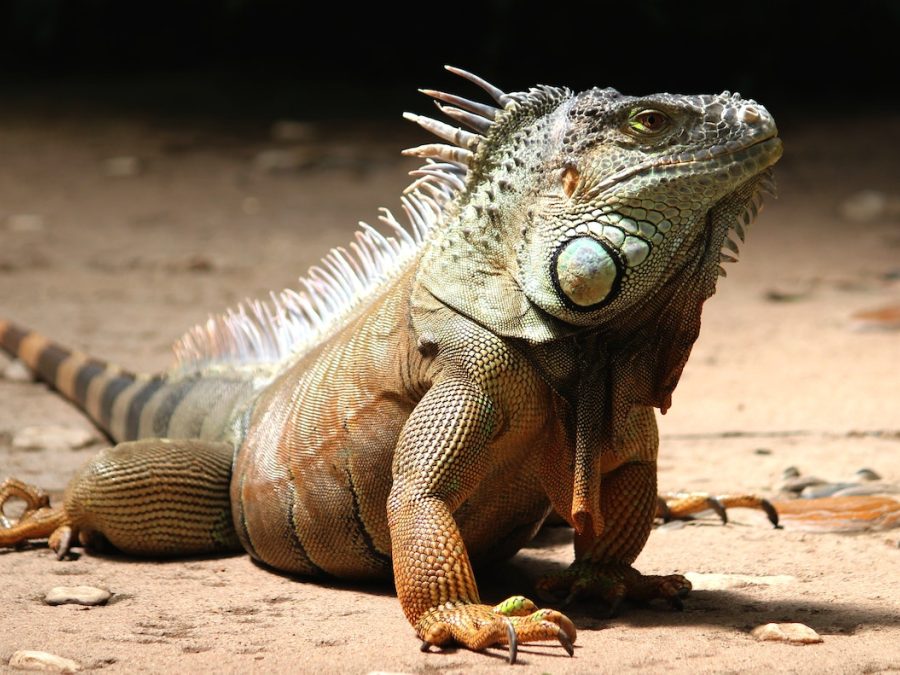
The iguana is a large lizard species and can grow up to 2 metres long in its entirety.
The green iguana is an excellent swimmer and will often jump into the water when in danger. Its greatest enemy is the hawk. Even the sound of a hawk in the distance can make an iguana freeze.
A funny fact about this iguana is that they have a third eye on their head. The eye does not have quite the same function as a normal eye but it can help the iguana spot predators coming from above.
If you were to lay the Amazon over the United States, it would cover over half of it!
28.South American Jesus Lizard
The South American Jesus Lizard or better known as the common basilisk is a lizard type that gets its name from the fact that it can run across water. When chased by predators the animal creates enough speed to create momentum after which it can run a short distance on the water.
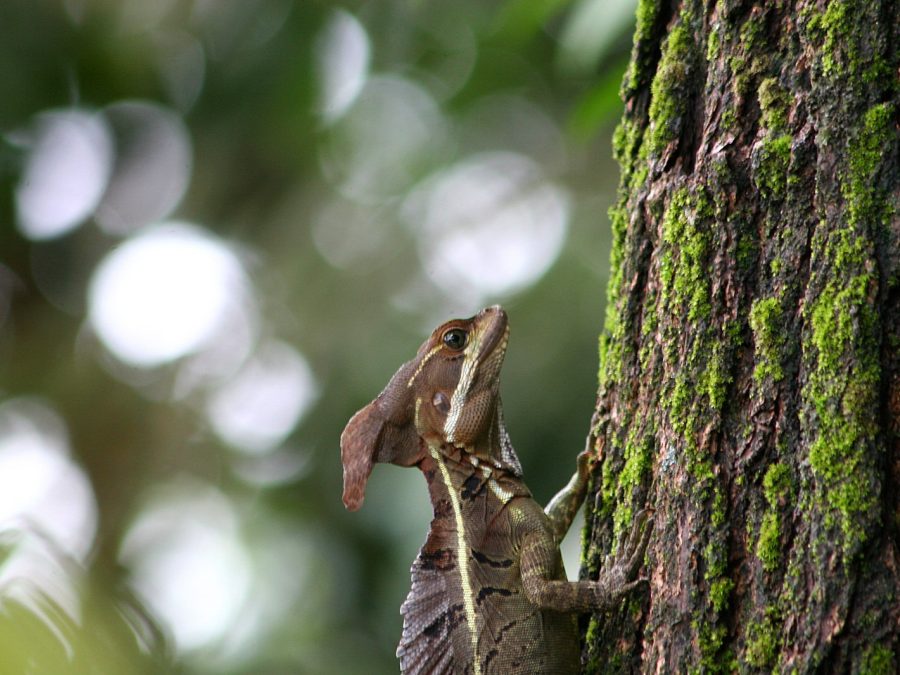
The animal has many different predators hunting it, so this technique helps this lizard avoid doom. Other larger reptiles, birds and mammals are very happy to make a meal of this lizard. The small lizard itself is an omnivore and its diet consists mainly of: beetles, dragonflies, flowers and small vertebrates such as fish, snakes and birds.
29.Arrau Turtle
This turtle is also called the ‘giant amazonian turtle’ in addition to the ‘arrau turtle’. The neck of this freshwater turtle cannot retract but is moved more to the side. This turtle type eats mainly plants. In addition to plants, they will also eat fruits and occasionally slow moving prey.
The outer ear of this turtle catches vibrations.
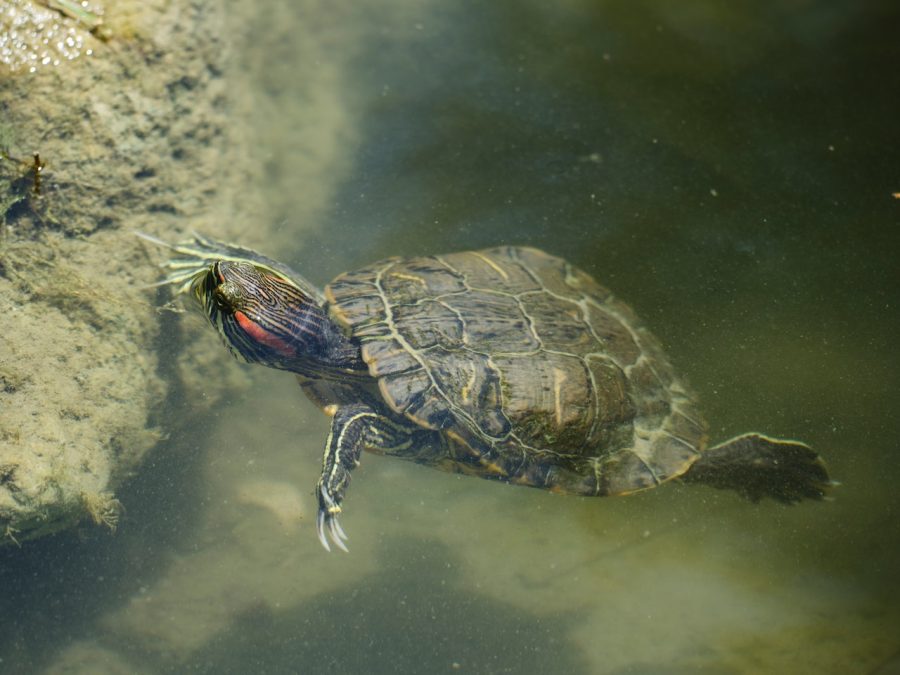
The hearing of these turtles is not as good as that of a human. These turtles have to make up for their bad hearing with their vision and sense of smell.
When the arrau turtle start mating they make different leg movements towards the females. Furthermore, this turtle also bites the hind legs of other female turtles to show that they are also an option.
30.South American Bushmaster
The South American Bushmaster is a black, brown, copper-colored snake and has one of the deadliest snakebites in the world. When this snake attacks, it strikes with lightning speed, producing massive amounts of venom that kills everything in its path. This snake gets its name from its camouflage.
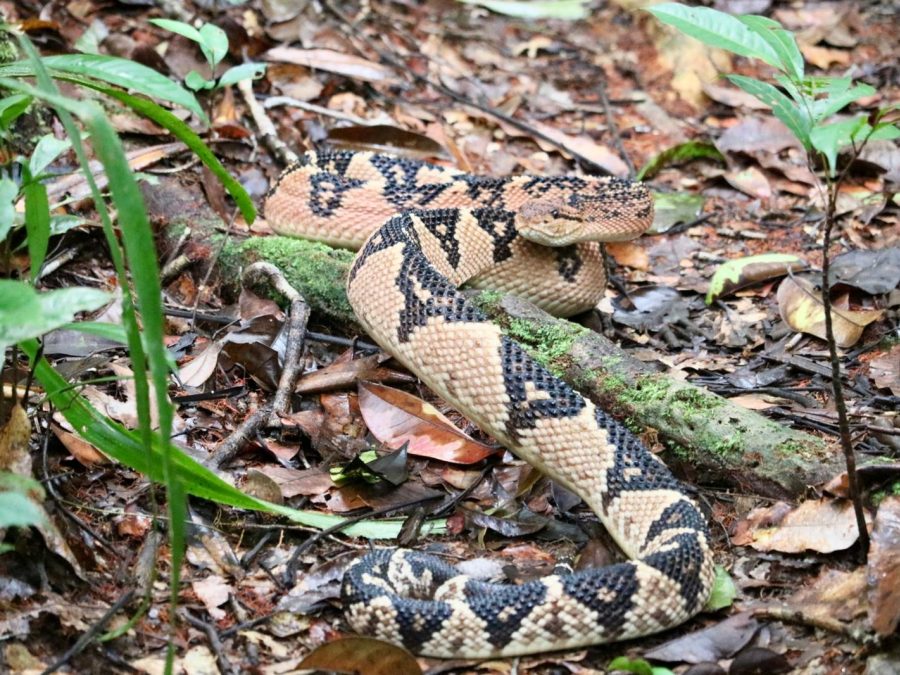
The snake is almost invisible when under the leaves, making it difficult to avoid. With a length of sometimes 2 metres, this snake is the largest venomous snake in the Western Hemisphere.
The snake hunts at night, using heat sensors near its nose to detect warm-blooded prey. The snake sometimes lurks for weeks along trails of mammals, until once the animal crosses the snake’s path, at which point it strikes quickly.
31.Giant Waxy Tree Frog
These frogs live in the drier parts of the treetops and survive by wax coming from special glands on their skin. They smear this wax over their skin so they prevent dehydration.
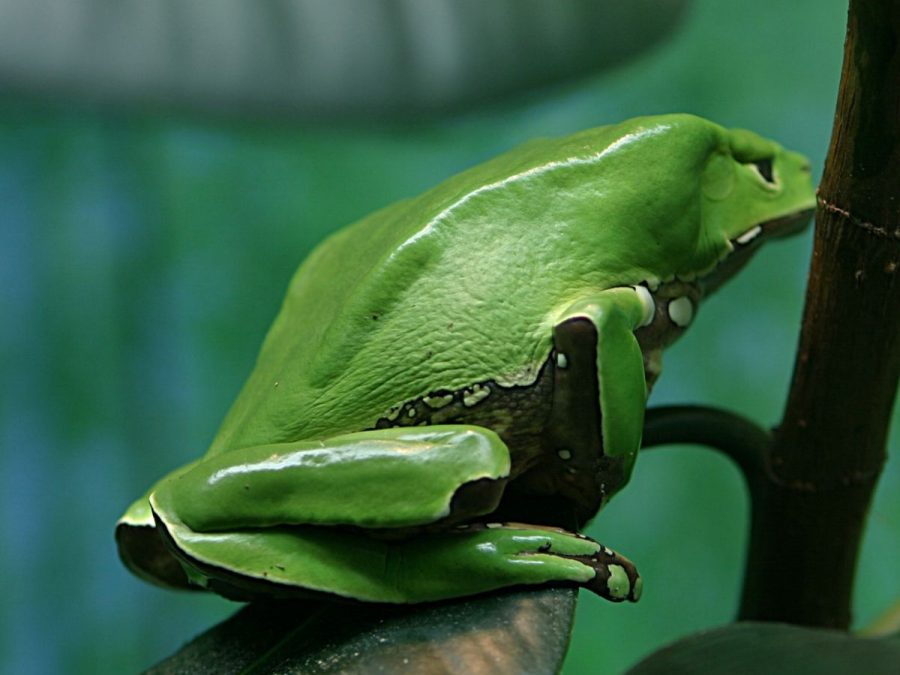
The eggs of this frog species are laid above the water. When the eggs hatch, the tadpoles fall into the water, where their life cycle begins.
This frog species often climbs the trees of the Amazon rainforest at a slow pace, searching for insects to eat. This frog is found in parts of Brazil, Bolivia, Colombia, Venezuela, Peru Guyana and French Guiana.
Insects & Fish
32.Blue Morpho Butterfly
Despite their beautiful colour, “Blue Morphos” are not really blue. Like all other butterflies, Blue Morphos have small overlapping scales covering their wings. The small ridges on the tips of its wings reflect the blue light, this makes the butterfly look blue. Unfortunately, the beauty and life of this animal is short. Its entire life cycle is about 115 days.
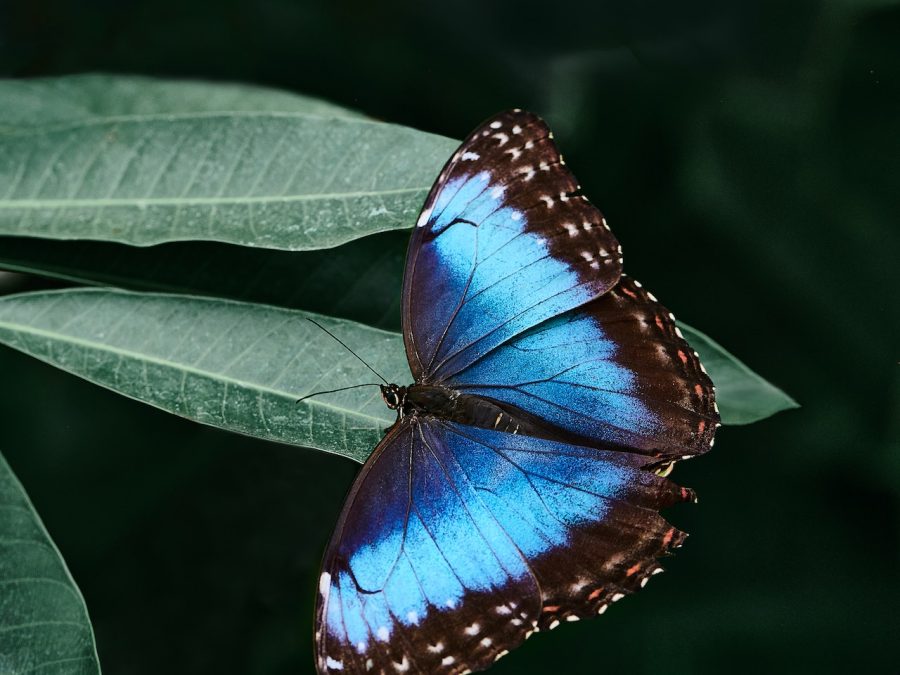
This bright blue critter does catch quite a bit of attention in nature. To deter predators, this butterfly has “ocelli” or eye patches on the underside of its wings for when the butterflies are resting.
A fun fact about this butterfly is that many native populations of the past associated the butterfly with all sorts of superstitions. These butterflies were alternately considered wish fulfillers or evil spirits. This animal has also been a source of inspiration for modern science. For example, the phenomenon has been closely studied and has become the basis behind the development of iridescent strips on banknotes against counterfeiting and energy-efficient colour displays for appliances.
33.Leafcutter Ants
The Leaf cutter ant is an ant that is often found at the bottom of the rainforest in central and South America. The reason the ant has this name is because this ant is often depicted as they transport leaves across the jungle floor. Because of this, the ant is also often called the parasol ant since it looks like the ant has the leaves above its head for protection from the sun.
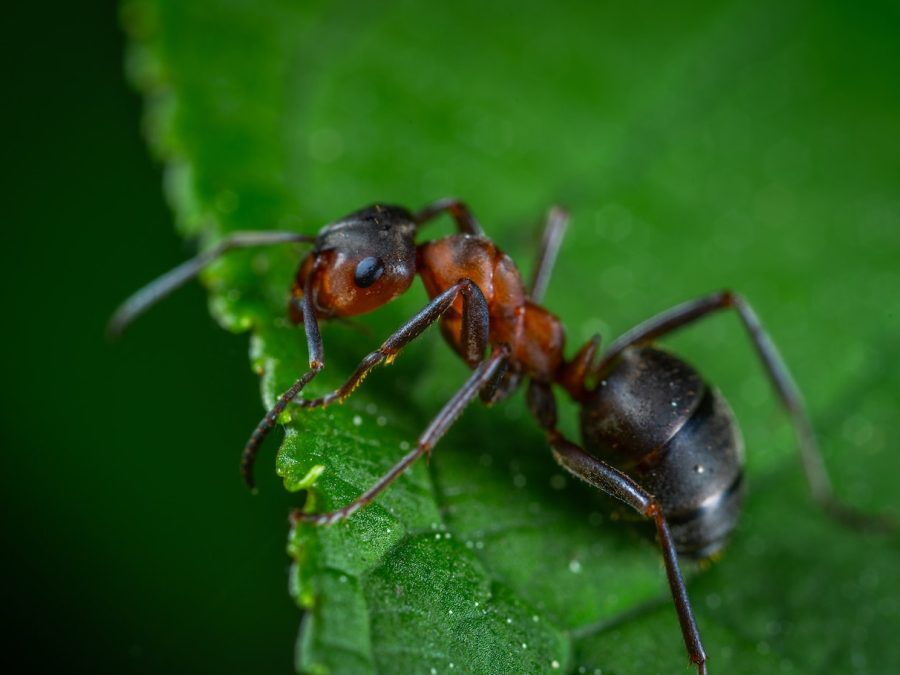
This ant is equipped with a kind of chainsaw jaws (unique to this ant species) that can vibrate a thousand times per second, this allows the ant to cut through leaves more easily. In addition to these chainsaw jaws, this ant can also lift 50 times its own weight. This is equivalent to a human being who can transport a minivan in their mouth, moving at the speed of Usain Bolt.
A Leaf cutter ant colony can consist of as many as 10 million ants, in which different groups of ants perform different tasks. For example, there are soldiers, trash carriers and workers. They also have an egg-laying queen.
34.Bullet Ants
The reason the bullet Ant is so called bullet ant is because of its powerful painful sting. People describe the pain from its sting as if you were hit by a bullet. This ant is also called the 24-hour ant in Venezuela, because the terrible pain lasts for about 24 hours. The sting of this ant is known as the most painful insect bite on earth. Even though the bullet ant is not extremely aggressive they do sting when provoked. When one of these ants stings they leave behind a chemical so that the other ants know danger is close. The other ants will absorb these chemicals and sting themselves repeatedly.
This type of ant is one of the largest ant species and they can grow up to 3 cm. They live in the tropical rainforest in the jungles of Central America and South America. Some of the indigenous peoples of the tropical rainforests use the bullet ant for a variety of ritual purposes. The Sateré-Mawé people use the bullet ant to turn the young men in the tribe into real men. They immerse the ant in a certain herbal soup so the ants are temporarily stunned. Then they braid these ants into large mittens that the young men within the tribe must wear. When the ants recover, they will fervently bite the hands of these young men. When the mittens have been worn 20 times the young men are considered warriors.
35.Goliath Birdeater Tarantula
The Goliath Birdeater Tarantula is the largest spider on earth with a span of about 12 inches. This spider does not normally eat birds but it is possible due to their enormous size. This spider resides in burrows in the ground or between the bark of trees. When prey passes by its hole the spider strikes quickly. The Goliath Birdeater Tarantula can be found in Brazil, Suriname, Venezuela and French Guiana.
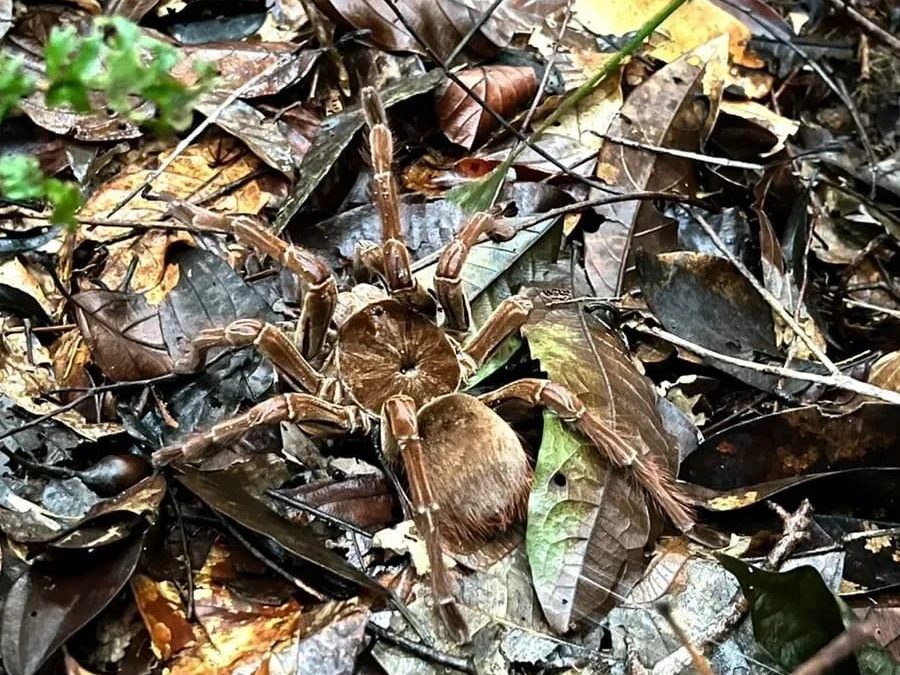
Unlike jumping spiders, these tarantulas have poor vision and rely on modified paw hairs which are sensitive to vibration. If certain predators get too close, they have a special weapon: the harpoon-shaped hairs! When they are in danger, the spider rubs its legs together and shoots some of these hairs into the air. These hairs will get on the skin and eyes of the attacker and will make him disappear. Although you would rather not be bitten by these spiders, the venom of the Goliath Birdeater Tarantula is not considered very toxic.
36.Jumping Spider
Jumping spiders get their name from the way they propel themselves. Most spiders hunt by weaving a web and waiting for prey to pass by. This is not the case with jumping spiders. These spiders hunt by stalking their prey.
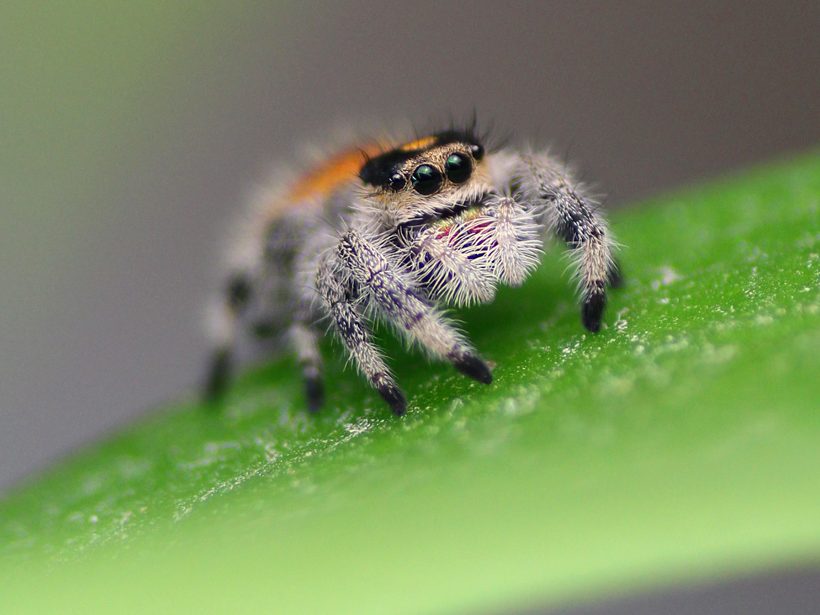
Jumping spiders have amazing eyesight. These spiders always have 4 pairs of eyes, including a large forward-facing pair of eyes. Despite their small body size, these spiders have better vision than elephants. Because of their large forward-facing eyes, these spiders look very cute and many people often lose their spider phobia after seeing one of them.
Many types of plants have adapted to give off poisonous toxins if an animal should come to close, using it to protect themselves from danger.
37.Amazonian Black Scorpion
The Amazonian Black Scorpion is a scorpion belonging to the Tityus family and is one of the largest within this family with a length of between 65mm and 100mm. As its name suggests, the distinctive colour of this scorpion is black. This scorpion is found in the rainforests of Brazil, Suriname and French Guiana.
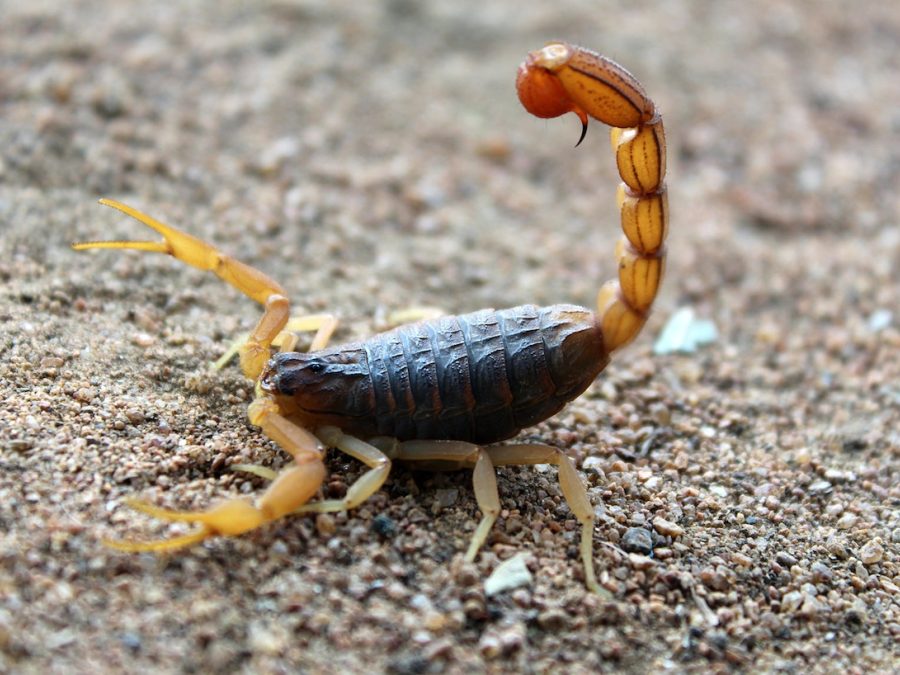
The Black scorpion is active at night and during the day it hides between tree trunks or bark.
The venom of a black scorpion is poisonous and can kill people. When hunting, the animal stings its prey one or more times (depending on the size of the prey) before the scorpion eats the animal. This scorpion can handle surprisingly large prey, sometimes it kills prey 150% of their own body size.
38.Brazilian Wandering Spider
The Brazilian wandering spider is also called armed spider or banana spider, and is one of the most poisonous spiders on earth. Even though it is unlikely that a bite from this spider could be deadly to humans. The Brazilian wandering spider appeared on the Guinness book of Records list of most poisonous animals in 2007.
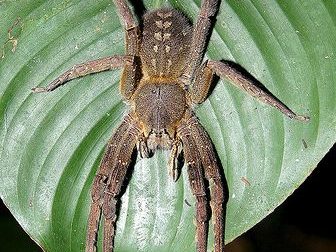
These spiders are very aggressive and mainly eat insects,
mice and small lizards.
There are nine species of Wandering spiders. All nine of these spiders are nocturnal and are found in Brazil. Some of these spiders are also found in parts of Central America and in other countries in South America.
39.Arapaima
This fish is among one of the largest freshwater fish in the world and can grow up to 15 feet (4.5 metre) long. The Arapaimas have a varied diet and eat fish, insects and fruit that fall from the trees into the water. In addition, they sometimes come out of the water to grab lizards, birds and even small monkeys from the trees.
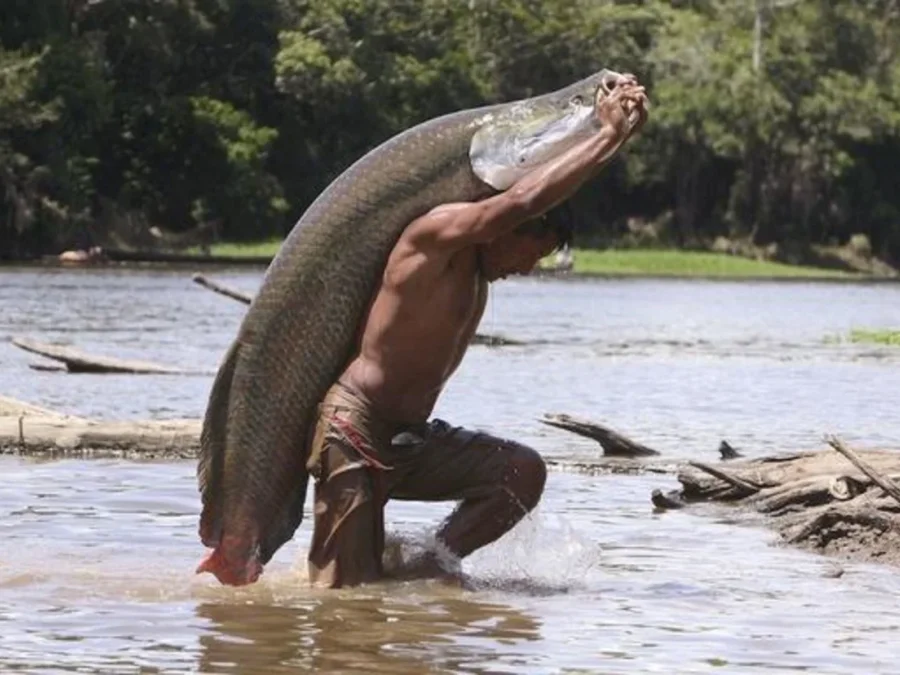
Arapaimas not only grow large they are also the fastest growing fish in the world, making them perfect for breeding. During the dry season, the Arapaima lay their nests, to hatch at the beginning of the rainy season (between October and November). The Arapaima reaches sexual maturity after about 5 years of age, and will live for a total of about 20 years.
40.Red Bellied Piranha
The Red bellied piranha has a red belly as its name suggests. The scales on the rest of the body have a greyish silver colour. Piranhas are known for their enormous biting power, which enables them to tear all types of prey to shreds.
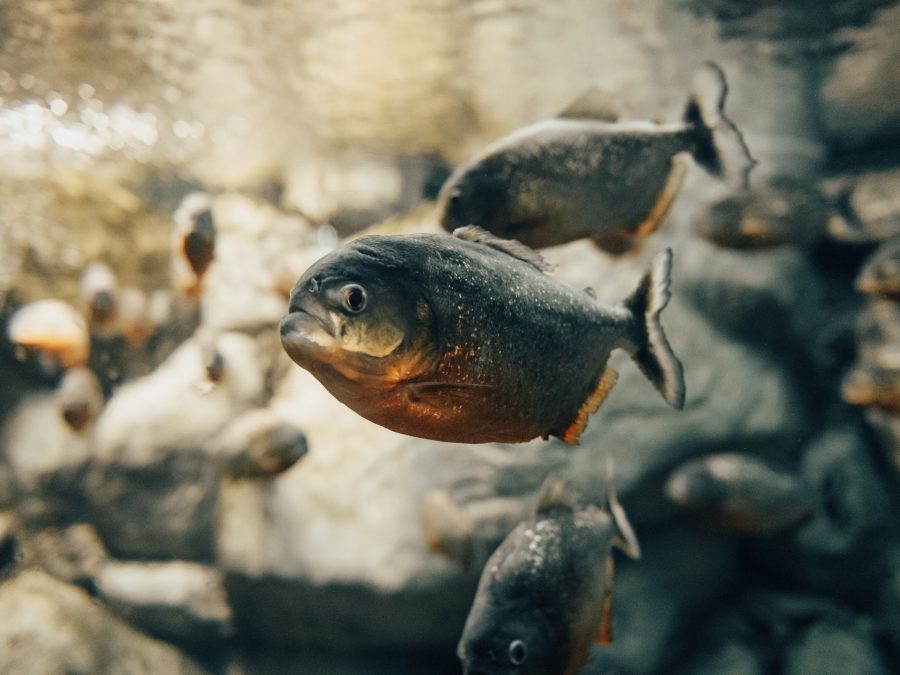
The red-bellied piranha are social fish and often live in large schools where they communicate with each other by means of sounds. They make a soft ‘croaking’ sound when biting at each other. To defend themselves from attackers they make a ‘drum like’ sound.
These Red bellied piranhas are known to be murderous pack hunters, yet they are not a real danger to humans. It sometimes happens that a group of piranhas eats a human being but then this person is often already badly injured or dead before the piranhas find it.

